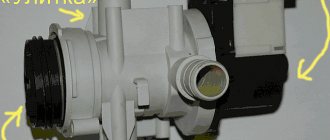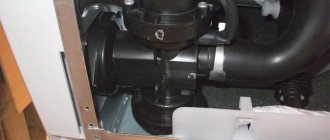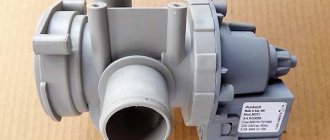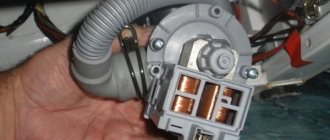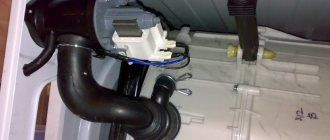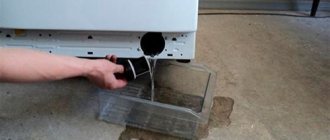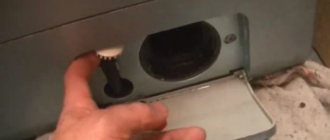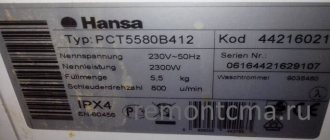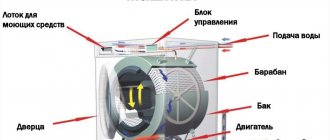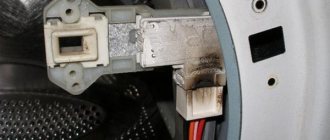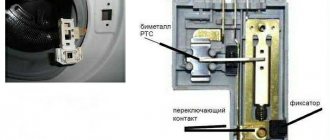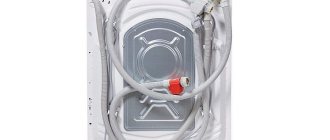An automatic washing machine is now found in almost every modern home. This irreplaceable assistant works tirelessly for years, but sooner or later, like any other equipment, it begins to fail. If problems arise at the stage of pumping or draining water, most likely the drain pump has become unusable. It is this that ensures the normal operation of the entire device. The pump for a washing machine is one of the main technical components, which is directly involved in every stage of washing.
Purpose
The washing machine pump performs one of the main functions in the correct and uninterrupted operation of the unit.
The main role of using a drain pump is to remove dirty water from the washing machine tank. The entire washing cycle depends entirely on how this unit works, because the pump is involved in all washing modes (washing, rinsing, spinning and drying). The need to periodically drain and collect water places a large load on the drain pump, so for trouble-free operation of the entire mechanism, you must follow the basic rules for operating the washing machine.
News
How to choose a drain pump for a washing machine
One of the important components of your washing machine is the drain pump (also called a “drain pump”), whose job is to pump water out of the washing machine tank.
Among the pumps in the world, the most widely used are pumps from two large Italian manufacturers, Askoll.
and Plaset
.
In one configuration or another, with various types of plastic “snails”, they are used in more than half of all washing machines produced in the world.
In addition to two well-known manufacturers of washing machine pumps, there are also pumps from the following companies:
Depending on the model of the washing machine and the type of snail, the drain pump motors are divided into:
— attachment to the drain volute;
— location and type of power terminals (contacts);
Let's take a closer look at each type of drain pump.
1. Based on the type of attachment to the volute, pumps are divided into:
— on latches (from 3 to 8 latches in a circle)
— on screws (from 2 to 5 screws in a circle)
There are configurations for attaching the pump motor to the volute using latches + screws.
2. By location and type of power terminals (contacts):
— terminals “for a chip” in front or behind relative to the impeller (propeller)
— terminals separately in front or behind relative to the impeller (propeller)
3. According to the power of the drain pump for a washing machine:
The power of the drain pump (pump) for a washing machine is usually from 25 to 100 W. Most pumps for a washing machine have a power of 34W (Plaset) and 40W (Askoll). More powerful pumps of 90 W and 100W (Plaset and GRE) were used by washing machine manufacturers at the end of the last century (as an example of the Indesit WDN2296XWU). These pumps were more reliable, but also more bulky and expensive to manufacture. With the development of technology and mankind's desire for minimalism, most manufacturers of large household appliances have switched to using inexpensive, compact pumps from 25 to 40W.
You can find the pump you need in our catalog of pumps for washing machines.
If you still have questions about selecting a pump for your washing machine, you can call tel. :8 (3452)603-220
Source of the article: https://www.smaster72.ru/news/view/56/kak_podobrat_slivnoy_nasos_dlya_stiralnoy_mashinyi
What is a drain pump?
Equipment should be disassembled only when the exact cause of the breakdown has been determined. Main symptoms of a malfunction:
- The water pumping system does not work when the drain program is turned on.
- The water drains, but is accompanied by a humming noise.
- Water leaves the drum more slowly than usual.
- The display shows a fault code (the meaning of the code depends on the model of the washing machine and is indicated in the instructions).
If the machine is not equipped with a display, then a breakdown is indicated by a combination of flashing lights on the panel.
Before you start repairing the pump yourself, you need to clean the drain filter, check the permeability and integrity of the drain hose, and whether the impeller is jammed. If this does not help, then you can begin repairing the drain pump.
The pump removal method differs for different models. The main methods and which brands are most often found:
- Disassembling the machine through the front panel (LG, Siemens, Bosch, machines with aquastop)
- Through the bottom, placing the machine on its side (Indesit, Ariston, Samsung, Ardo)
- Through the back cover (Candy, Electrolux, Zanussi)
- For vertical speakers: through the side cover
Step-by-step procedure for dismantling the pump:
- Remove the detergent and softener container.
- Remove the top cover. It is usually mounted on the back wall.
- Remove the control module. Carry out dismantling carefully. Advice! Before removing the control module, it is recommended to photograph its location.
- Removing the panel above the hatch.
- Remove the front panel.
- Carefully disconnect the wires from the blocker and remove the bolts.
- Removing voltage supply parts from the pump.
- Dismantling the hoses going to the pump.
Now you can repair the washing machine pump yourself. To do this, blockages are removed or the part is completely replaced.
To dismantle the pump through the bottom:
- Unplug the machine, disconnect the hoses, lay it on its side
- Remove the front strip on the front panel, behind which the filter cover is hidden
- Unscrew the two mounting bolts that hold the pump
- Turn the pump counterclockwise and remove it from the grooves
- Unscrew the clamps holding the inlet and outlet hoses and remove the terminals
- Unscrew the 4 bolts connecting the pump and filter
The sequence for dismantling the pump through the rear panel:
- Disconnect the machine from the network, unscrew the inlet hose
- Unscrew the screws holding the cover around the perimeter
- Pull the back cover towards you and remove it
- Disconnect power to the pump by removing the terminals
- Tilt the machine, unscrew the 2 bolts holding the pump at the bottom
- Using pliers, remove the clamps that hold the pipes on the pump
- Remove the drain hose, pull out the pump
In models with vertical loading, you can reach the pump through the side wall in the following sequence:
- Disconnect the device from all communications, provide access to equipment
- Remove the inlet hose
- Unscrew the screws on the rear wall along the edge (in some models the side panel is also held in place by fastenings at the front) of the model and remove the panel by pulling it towards you
- Remove terminals
- Unscrew the screws holding the pump
If you follow these recommendations, you can significantly extend the life of the drain pump.
- Always remove foreign objects from pockets before washing.
- Use bags for washing clothes.
- In case of strong, coarse dirt, clean things, and also remove animal hair by hand before entering the machine.
- Install filters at the inlet of the filler pipe.
- Carry out scale prevention.
- When washing items with buckles or rivets, turn the items inside out.
Structurally, the drain pump (pump) for a washing machine is a low-power electric motor, on the shaft of which an impeller is mounted, which helps pump out used water.
The main components of the pump are:
- medium power electric motor;
- electric motor shaft;
- impeller;
- sealed casing in the form of a snail with two pipes.
One pipe of the housing is used to remove water from the washing machine tank, and the second is connected by a drain hose to the sewer.
The main characteristics of different models of washing machine drain pumps may vary depending on the power of the units.
Standard technical indicators are:
- productivity about 20 liters of water per minute;
- rated power of the electric motor is about 30 W;
- the motor winding has a resistance of about 160 Ohms;
- the ability to lift water up to a maximum of one meter;
- The water temperature should not be higher than 90 °C.
To protect the electric motor winding from overloads, a thermal relay is installed, which is designed to operate at a coil temperature of 150 °C.
During the washing process, the washing machine pump is switched on several times, depending on the selected mode. Therefore, a large load on the parts of this important unit is the main reason for pump failure.
Typical drain pump malfunctions are:
- frequent activation of thermal protection of the electric motor winding;
- clogging of the impeller, which leads to its jamming;
- damage to the impeller blades by foreign objects;
- premature wear of the bushings located on the motor shaft;
- the pump impeller rotates or falls off the electric motor shaft;
- short circuit or broken motor winding turns.
All these breakdowns lead to repair of the washing machine pump. Typically, repair work can be carried out after minor faults occur, such as clogged impellers, as well as minor damage to the blades. Other breakdowns lead to a complete replacement of the washing machine pump.
To begin with, the main function of the pump is to pump water out of the main drum, which is used for washing clothes. Its structure is quite simple and consists of the following elements:
- snails;
- wing motor.
Most experts hasten to assure that a device of this type belongs to the category of almost eternal ones, which are quite difficult to break. If a breakdown occurs, after a quick replacement the device can continue to be used for other tasks. The type of unit in modern washing machines is the same - synchronous with a magnetic rotor.
It does not have any special suction characteristics, so two pumps are often installed simultaneously. The motor has a power of 20 W sufficient for its functions. Thus, the developers are trying to reduce the load on the main pump as much as possible, dividing its direct responsibilities equally - one performs overhead watering, while the second is responsible for pumping out water.
Choosing the most optimal siphon will not be difficult due to the variety of similar products on the modern market. Mainly they differ:
- by the number of bends used;
- by installation method;
- according to form;
- and in size.
Sometimes you can find a siphon of such an unusual or intricate shape that it will be impossible to determine what type of device it is and how it can be used. The choice of pump should be approached very carefully, since the complexity of connecting the pump to the sewer system and its further operation will depend on this.
We suggest you familiarize yourself with the Samsung washing machine drain filter where it is located
With an outlet for a washing machine, some pumps look really unusual. However, it often looks like an ordinary siphon, which everyone has seen at least once under their own or a neighbor’s washstand. Additionally, it comes with a pipe or side outlet to which you can attach a drain hose.
The branched siphon allows you to take care of double connections at the same time. It is a plastic tee. One outlet will be directed to the sewer pipe, while the rest will act as containers for corrugated hoses. One will be directed to the sink, and the second will be connected to the washing machine.
The siphon built into the wall has very insignificant dimensions due to the fact that most of it will be hidden in the wall by the sewer pipe. Only a small part of the housing with a connection for the drain hose will be visible. It can be equipped with several or only one branch at the same time. A relatively new invention is a siphon equipped with a check valve.
This will help avoid many troubles in the event of a clog forming, blocking the return of liquid to the washing machine. A very popular device among apartment dwellers. Flat drain pumps are very convenient to use, since their dimensions allow them to be placed anywhere and at a short distance from the main device.
lt;lt;/divgt;
Additional uses of drain pumps
Before we consider in more detail the possibilities of using a drain pump separately from the main device, it is necessary to pay attention to the power of a small motor located on the pump, which allows it to be used if there is a need to lift liquids from a shallow depth. The maximum value of this value is half a meter. You should not count on significant processing, since with each inch of elevation its power will only become lower. For household needs it can be used:
- If there is a small difference between levels for pumping liquids.
- When establishing an automated irrigation process.
- To maintain a certain water level in artificial reservoirs.
- For the operation of a small waterfall or fountain on the surface of a reservoir.
If desired, you can find a use for just the motor by carefully removing all other elements. It will help solve many technical issues that people encounter in everyday life. You can even use it to make a mini-wash for a car or moped. It will take a long time to wash, but it will be interesting. Such devices are not intended for long-term supply of liquid, which should also be taken into account.
Washing machine pump: principle of operation, types, do-it-yourself replacement
An automatic washing machine is now found in almost every modern home. This irreplaceable assistant works tirelessly for years, but sooner or later, like any other equipment, it begins to fail. If problems arise at the stage of pumping or draining water, most likely the drain pump has become unusable. It is this that ensures the normal operation of the entire device. The pump for a washing machine is one of the main technical components, which is directly involved in every stage of washing.
Equipment disadvantages
Like any other device, drain pumps have a number of disadvantages. These include the relatively low power of the motor, the use of which in everyday life will be extremely problematic. You should not expect a long service life from a repaired pump, and after the first breakdown, it is recommended to immediately replace such equipment. For local solutions it can be used, but only as an additional element that overheats and makes noise. After a relatively short period of time, its performance will practically be equal to 0. Further use of the repaired pumps is not recommended, therefore any subsequent manipulations will be carried out solely at your own peril and risk, without any guarantees of reliability and safety. They are able to perform only a narrow range of tasks and are unlikely to be able to jump over this threshold. Most instructions indicate that further repair and disposal are provided, but almost every craftsman tries to use all the surviving parts to produce new and serviceable equipment.
The most common causes of breakdowns
When a washing machine pump breaks, it completely stops pumping water from the main drum. The cause can be a variety of malfunctions. One of the simplest and at the same time correct solutions is to completely replace the broken element. It is possible to repair such equipment, but there is no guarantee of its continued performance, and no one can say how long it will continue to work. Therefore, in any case, the best option will be a complete replacement of the drain pump for the washing machine. If you purchase a warranty product, you can automatically add several years to the life of the main device. In addition to completely maintaining factory specifications, the device will stop making extraneous noise. Installing an additional filter also helps to increase the service life.
List of the most common causes of washing machine breakdowns:
- Failure of a mechanism such as an impeller.
- There was a short circuit or break in the winding.
- The motor bushings are completely worn out.
Often, only those craftsmen who stubbornly refuse to take care of the basic elements of the device they use buy new elements. The cost of a drain pump is low, but it is better to prevent breakdowns in every possible way than to regularly contact a service center and clean up the consequences of another flood.
For this you will need:
- use the most ergonomic and correct mode for washing. Washing for too long will not benefit both your clothes and the operating device, which will definitely break;
- Do not place too hard or metal objects into the drum (keys and coins should be pulled out of your pocket in a timely manner). They can cause the pump to jam. Additionally, it is recommended to install a filter on the pump.
Uncharacteristic sounds may be the first signal that your washing machine is breaking down. A hum or excessive vibration may appear exclusively during draining of water and indicate its possible breakdown.
You may also like
29.01.2018
07.05.2018
20.11.2017
Drain pump device
- If there is a small difference between levels for pumping liquids.
- When establishing an automated irrigation process.
- To maintain a certain water level in artificial reservoirs.
- For the operation of a small waterfall or fountain on the surface of a reservoir.
If desired, you can find a use for just the motor by carefully removing all other elements. It will help solve many technical issues that people encounter in everyday life. You can even use it to make a mini-wash for a car or moped. It will take a long time to wash, but it will be interesting. Such devices are not intended for long-term supply of liquid, which should also be taken into account.
Required Tools
Repairing the pump is simple, as it does not require many tools or special devices. Most often, three things are enough for dismantling and repair:
- Phillips screwdriver;
- sharp knife or chisel;
- electric voltmeter.
Pliers or pliers are useful as auxiliary tools to remove the clamps from the hoses.
Prepare a dry rag and bucket in advance . There will likely be a small amount of water in the pump that will spill onto the floor.
Causes of failure
- The pump broke down due to a malfunction of the engine, as a result of which there is no voltage to the pump.
- The seal (rubber or plastic) is damaged by scale and dirt that settles on the impeller.
- Incorrect connection of the pump or failure of the water level sensor causes the pump to constantly operate.
- The pump will not be able to drain water due to a clogged filter.
- Small foreign objects destroy the impeller. It's easy to diagnose. When the pump starts, the machine makes a hooting sound.
When a washing machine pump breaks, it completely stops pumping water from the main drum. The cause can be a variety of malfunctions. One of the simplest and at the same time correct solutions is to completely replace the broken element. It is possible to repair such equipment, but there is no guarantee of its continued performance, and no one can say how long it will continue to work.
Therefore, in any case, the best option will be a complete replacement of the drain pump for the washing machine. If you purchase a warranty product, you can automatically add several years to the life of the main device. In addition to completely maintaining factory specifications, the device will stop making extraneous noise. Installing an additional filter also helps to increase the service life.
We suggest you familiarize yourself with How to wash a down jacket in an automatic washing machine
List of the most common causes of washing machine breakdowns:
- Failure of a mechanism such as an impeller.
- There was a short circuit or break in the winding.
- The motor bushings are completely worn out.
Often, only those craftsmen who stubbornly refuse to take care of the basic elements of the device they use buy new elements. The cost of a drain pump is low, but it is better to prevent breakdowns in every possible way than to regularly contact a service center and clean up the consequences of another flood.
For this you will need:
- use the most ergonomic and correct mode for washing. Washing for too long will not benefit both your clothes and the operating device, which will definitely break;
- Do not place too hard or metal objects into the drum (keys and coins should be pulled out of your pocket in a timely manner). They can cause the pump to jam. Additionally, it is recommended to install a filter on the pump.
Uncharacteristic sounds may be the first signal that your washing machine is breaking down. A hum or excessive vibration may appear exclusively during draining of water and indicate its possible breakdown.
If the machine pump fails, it can completely stop pumping out liquid. Such a breakdown can occur due to various malfunctions. The simplest solution is to completely replace the pump in the washing machine.
You can repair your electric pump, but there is no guarantee (and no specialist will give it) that you can use the machine for a long time. How long it will last after repairing the pump is unknown. It is better to purchase a new drain pump for your washing machine.
And by purchasing a new pump for a Samsung washing machine (Zanusi, Askol, Indesif, Ariston, etc.), you get an additional 15 years of device service. Such a device will stop making noise and retain factory characteristics. And if you install a drain pump filter, the service life will increase by another couple of years.
When purchasing an original pump for a Zanussi, Indesit, Ariston, etc. washing machine, you should rest assured that these devices are made of the highest quality, taking into account all modern requirements and technologies.
Here are the most common breakdowns of washing machine pumps (each of them requires pump replacement):
- Wear of motor bushings.
- Winding break/short circuit.
- Impeller failure.
Those who buy a new pump for a washing machine are often those who use it incorrectly. Yes, a washing machine drain pump is inexpensive, but it is better to prevent it from breaking.
What is needed for this:
- make sure that solid elements are not “erased” in the drum - coins, keys, etc., which can jam the pump. It is best to install a special washing machine pump filter (inexpensive);
- choose the right modes when washing. Do not set the timer for too long - this will lead to breakdowns.
The first signal of a breakdown is uncharacteristic sounds. So, the machine may hum (sometimes it makes a lot of noise), rattle, etc. A particularly loud sound may occur when draining water.
Washing machine drain pump
Modern washing machines usually produce error codes. They will signal that the device is faulty. Of course, they are different for each manufacturer.
To find out them, you should read the instructions for the device, or go to the manufacturer’s official website. There you can find not only error codes, but also useful recommendations for servicing devices.
It all depends on the specific brand and model of the device. But, usually, you first need to unscrew and remove the cover, unscrew the pump’s mounting bolts (cleaning is also carried out at this stage), replace the pump, and send the unscrewed one to the trash heap or sell it to a mechanic for spare parts.
If you cannot buy a new pump, you can always purchase used equipment - take a pump from a washing machine of a similar model, select the necessary working element, and replace it. This should be followed by a check of the equipment.
Below are the main causes of the malfunction, as well as how to fix them yourself.
A clog is indicated by an unusual humming sound when the machine cannot drain the water. The causes may be objects that have gotten inside the pump or hose, into a pipe, sewer, or during the water supply.
There are two types of blockages. Mechanical occurs when foreign objects get into the hose: buttons, coins, etc. They block the passage of water into the system. Natural clogging is when hair, lint and other small debris get into the filter.
The first type of blockage is easy to prevent. Before washing, it is necessary to carefully check all pockets, fasten all buttons and use special mesh bags for clothes. The second type occurs over time and is difficult to prevent completely, so once a month or less, depending on the frequency of use of the machine, it is necessary to clean the hose and filter.
A filter for mechanical water purification will prevent clogging of the supply hose; the main thing is to change it periodically, depending on the type of filter used.
Part wear
The wear of the pump is caused by foreign objects and debris getting into it, and the machine begins to make a lot of noise. The average pump life is 10-12 years. Operating time may vary and depends on frequency of use.
Hard and dirty water leads to scale formation and reduces the life of the pump. It is recommended to use water softener with each wash cycle.
Practical recommendations for preventing wear on the washing machine pump:
- Thoroughly clean clothes from pieces of dirt
- Check pockets before washing
- Install an inlet filter
- Use water softeners when washing
Before washing pet bedding, they should be thoroughly cleaned of hair (this is especially true for owners of long-haired dogs and cats). It is wool and hair that become one of the reasons for rapid wear of the pump.
- After the end of the wash cycle, drain the water from the tank completely
- Clean the external filter periodically
- Compliance with the recommendations increases the service life of the pump by at least 4-5 years.
Contamination is not the only reason for device malfunction. When the bearings fail, runout occurs during shaft rotation. Due to the beating, the impeller begins to rub against the volute casing. This causes noise and unproductive operation of the pump, up to a complete stop.
If at the moment it is not possible to buy a new part, and washing cannot wait, then you can temporarily extend the life of the pump by shortening the blades by 2 millimeters with a sharp knife. But don't overdo it: if you cut more, the system's performance will drop.
After cleaning, replacing bearings or seals, the motor repair can be considered complete. Install the body with the blades into the reel and secure with latches. Subject to safety rules, connect 220 V voltage to two contacts and check the operation of the device. After making sure that the device is operating normally, you can connect the cochlea and return the entire structure to the SMA body.
As you can see, repairing a washing machine pump with your own hands is not such an impossible task and can be done by anyone who carefully reads these recommendations.
We suggest you read How to get rid of the second hand smell on things
Connecting a washing machine in a house without running water
You can pour washing water into the automatic washing machine through the compartment designed for supplying powder to the unit. The technique is simple, but truly tedious. You will have to constantly be near the machine and add water to it as needed. All the comfort from operating an automatic unit, as you understand, disappears.
Another way is to place above the machine (for example, on the second floor of a building or in the attic) a sufficiently capacious container from which water will be supplied. The option looks reasonable. But in practice it is often very difficult to translate into reality. After all, the container should be located at a high altitude (ideally 10 m). It is with this raising of the tank that a pressure of 1 bar will be created in it, which is necessary to supply water to the washing unit. In addition, you have to constantly carry water to the second floor and fill the container. Considering that one wash requires from 100 to 200 liters of water, such physical procedures are not suitable for every summer resident.
Reservoir for supplying water to the washing unit
And in the case when the attic space in the house is unheated, the option with a tank is completely eliminated. In winter, the water in it will simply freeze. You can also drill a well in your country house and connect the washing machine to it. The solution seems good. You have a constant source of water for which you don’t have to pay. But the costs of constructing a well (calling drilling specialists, conducting geodetic surveys to search for an aquifer, installing pipes, a storage tank and a special pump) can, without exaggeration, be prohibitive.
If you visit your dacha often (or live in a city in a private house without running water), you can install a pumping station in your home. It will ensure the supply of water to the automatic washing unit at the required pressure.
True, the cost of such a station is quite high. Not everyone wants to suffer with its arrangement because of the washing machine. For thrifty owners who do not want to spend excessively, there is only one way to connect an automatic machine in the country. We talk about it further.
Removing the pump through the front panel
The drain pump is located at the bottom of the unit, under the tank. Only it can be accessed through the bottom of the washing machine or after removing the front panel.
Replacing the pump for a Samsung washing machine is done through the bottom of the unit.
Instructions for dismantling the drain pump are as follows:
- Be sure to unplug the washing machine from the electrical outlet.
- Shut off the water supply before disassembling.
- Carefully place the washing machine on its side. In this case, the pump should be on top of the unit.
- Release the bottom of the machine from the lower protective panel. For this purpose, it is necessary to remove the fastening latches.
- If there is a plastic protective casing for the pump, this element must also be removed.
- Near the pump valve you will see screws securing the unit, which need to be unscrewed.
- Carefully pull the pump towards you.
- Then disconnect the pump power cables.
- Over a previously prepared container, so as not to spill the remaining water, loosen the hose clamps.
- If the pump has a volute, then you need to disconnect it too. In the future, if there are no complaints about this element, then after cleaning the snail can be left.
Installing a new or repaired pump is carried out in the reverse order.
A similar method is used to dismantle the pump in washing machines Indesit, LG, Beko and some other models.
Replacing the pump of a Bosch, Siemens and some other brands of washing machines is done after removing the front panel of the unit, since the bottom of such machines is closed.
Dismantling the drain pump is carried out as follows:
- First of all, you need to remove the top cover of the unit. To do this, you need to unscrew the mounting screws on the back of the machine, and then push the cover away from you from the front panel.
- The next step is to dismantle the control panel. For this purpose, remove the tray for washing powder and unscrew the screws securing the panel. After removing the screws, the panel is carefully placed on the top of the unit so as not to damage the connecting wires.
- Under the plastic protective panel there is a drain valve, which must be carefully removed above the container to drain the remaining water.
- Then you need to remove the sealing collar from the loading hatch.
- Thus, by dismantling the front panel, we will gain access to the pump.
- Having unscrewed the mounting screws of the pump and the front wall, you can begin to dismantle the pump.
- Having loosened the clamps on the pump nozzles, remove the connecting hoses.
After completing all these operations, we inspect the pump and impeller. In case of minor breakdowns, we clean the pump parts from contamination. Installing a new drain pump is done in the reverse order.
In top-loading washing machines, the pump is removed through the rear wall.
Remove the pump in the step-by-step sequence described above. Examine the pump in detail and determine whether a complete replacement of the washing machine pump is required or whether the snail can be left.
Before installing the pump, it is necessary to clean the volute and the pump mounting area from dirt. Then the pump is screwed on and the pipes are connected.
A new pump is selected based on the following indicators:
- Mounting method: bolts or snaps.
- The location of the contacts is front or rear.
- Connection to the network - with terminals or chips.
- Power – from 19 to 20 W.
Let's look at how to replace the pump in a LG, Indesit, Beko and Samsung washing machine.
The drain pump for a Samsung washing machine (and the brands listed above) is quite expensive. But, it is very easy to replace - there is no need to dismantle the machine panels, all work is done through the bottom of the device.
How to remove the pump from the washing machine and install a new one:
- Disconnect the device from the power supply.
- Turn off the water.
- Lower the machine on its side so that the pump in the washing machine is closer to the top (tip: before removing the bottom, it is better to lay a soft cloth under the side of the washing machine).
- Remove the bottom of the unit (usually it is held on by small latches).
- Unscrew the part.
- Pull the device out.
- Disconnect the pump from the board.
- Loosen the clamps holding the pipes and drain the remaining liquid.
- Remove the drain pipe and hose.
- In complete contrast, install a new device.
Washing machine circulation pump
The pump for the “German” washing machine is expensive. And its replacement is not as simple as in the previous version.
The bottom of Siemens and Bosch cars is inaccessible, therefore, we will make our way into the inside of the car through the front panel.
Your actions:
- Remove the top part of the machine - unscrew the mounting screws from the back.
- Pull the cover up, unclip it and remove it.
- Remove the internal PVC panel behind which the drain valve is located.
- Disconnect the valve from the system and place the remaining water in a “drained” container.
- Pull out the container for washing powder, disconnect the bolts securing the control panel, and dismantle it.
- Remove the cuff from the front wall and place it inside the drum for convenience.
- Unscrew the pump fasteners (bolts or screws).
- Unscrew the fasteners of the front wall of the machine and remove it.
If everything went well, you can connect the pump for the Bosch washing machine:
- Disconnect the pump from the network.
- Loosen the clamps and drain the remaining liquid.
- We take out the device.
- We are installing a replacement.
Replacing the drain pump in a Bosch washing machine is complete!
The pump for Ariston, Zanussi and other top-loading washing machines can only be replaced through the rear panel. But, this is not just a panel, but a part of the machine with circuit boards and functional parts.
Cleaning the drain filter in front of the washing machine pump
The sequence is similar to “horizontal” devices:
- Unscrew the fasteners of the rear panel and remove it.
- Remove all bolts securing the back of the device.
- Disconnect the outlet valve and drain the water.
- Remove the non-working part and connect a new one.
If the machine’s impeller is noisy, or it’s just noisy and makes uncharacteristic sounds, then most likely the pump in it is broken. It can be repaired - contact a specialist, or do it yourself.
Every man should know how to repair a pump, but it is difficult to give specific instructions, because pumps are very different from each other. It is also important to know how to clean the pump in a washing machine - unscrew all the fasteners, wipe the surfaces dry, lubricate the moving elements, etc.
If you doubt anything, then you should not try to correct the situation yourself. Today there are a lot of craftsmen who, for a reasonable fee, do all the work quickly and efficiently.
An automatic machine without running water – is it necessary?
In places where there is no central water supply, automatic washing machines are rarely used. Most people in the village use old washing machines, into which water is poured manually. If you want to enjoy all the benefits of modern civilization, you cannot put up with this state of affairs. And there is no need. After all, if you wish, you can connect a washing machine in the country or in a private house without running water.
Connecting a washing machine in a country house without running water
Of course, to implement this idea you will have to “sweat.” But the result of the work is worth it. The advantages of using automatic washing machines outside the city (for example, in the country) are many. Let's highlight the main ones:
- You can use rainwater for washing. In terms of its performance, it is many times softer than well and tap water. This water washes any items efficiently and at the same time as carefully as possible.
- If you have a well at your summer cottage, you won’t have to pay a penny for water. Do your laundry every day, using the gifts of nature absolutely free.
- You can send an old but still fully functional automatic machine to your dacha, instead of which you purchased a more modern model for your city apartment. The outdated unit will serve you faithfully outside the city for many more years.
As you can see, an automatic machine makes doing laundry at the dacha not only convenient, but also profitable.
Pump operating rules
In order for any complex technical unit to reach its service life, you need to monitor its condition and follow some additional recommendations from the washing machine manufacturer:
- Before washing, check the pockets in your clothes to prevent small objects from getting into the rotating components of the unit.
- Use only a special detergent for automatic machines, which contains anti-scale additives.
- It is advisable to install a filter on the water supply system so that small particles of rust from the pipes do not get inside the machine.
- It is better to soak very dirty laundry before washing.
Remember that if signs of a problem with your washing machine appear, you must immediately begin to identify and repair the problem. It is easier to replace a failed drain pump than to replace the entire unit in the future.
Washing machine pump: types, design, characteristics, malfunctions and their elimination
In every modern apartment you can see an automatic washing machine in the kitchen or bathroom.
Currently, manufacturers offer a huge number of different brands and models of washing units, which operate on the same principle, but are most often equipped with technological components of their own production. Experienced craftsmen call the heart of the washing machine the drain pump, which ensures the normal functioning of the entire unit. Therefore, when a home assistant malfunctions, it is often necessary to know the types, classification and characteristics of pumps. Knowledge of the operating rules and features of caring for the washing machine pump will greatly extend the trouble-free service life of the entire unit.
